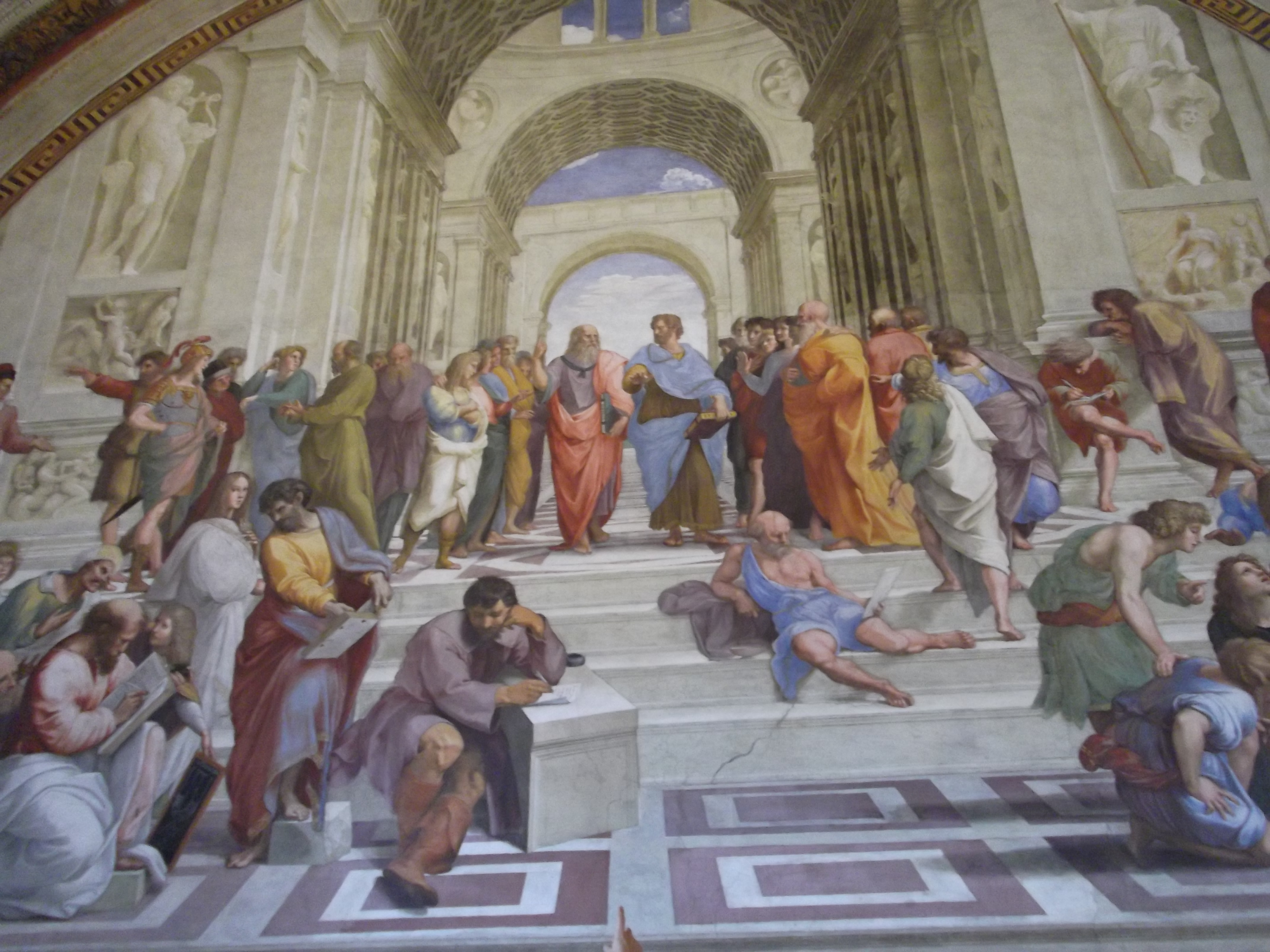KATERI AND THE OTHERS

I returned to the Sistine Chapel today with new eyes and a new heart –
Earlier, the sun blazed warm and bright on a run through the park to Villa Borghese. Children were laughing and playing, and couples walking hand-in-hand. From the escarpment the seven hills of Rome rose and fell like its long bloody history; but today, beneath this blue sky, nothing could go wrong.
Pilgrims were everywhere in the sunny streets. Clerical dress, habits of white and brown and black cassocks as the religious mingled with the laity in shorts and sandals. In the metro and along the sidewalk cafes there was a holiday mood until I entered the Vatican Museum. There the art, its elegance, its sublimity, its sheer profusion, overpowered the senses. We passed through the apartments with murals by Raphael and DaVinci and into the Sistine chapel where the light was dim.
I’d been here three times before, gazed up with tears streaming down my face at the incomparable beauty of his conception. Not even Botticelli can distract your eye from the over-arching scenes of his Genesis creation story. Today, though, the chapel seemed shaded after the sunny streets, sacred and lofty and sublime to be sure, but more introspective.
My new eyes and heart came from soon-to-be Saint Kateri. She is ascending into these sacred precincts and we, of her homeland, may follow.
The intermingling of life and sanctity and art was overpowering. How often have I stopped in LaPrairie on the way home from Montreal just to kneel at her sarcophagus and leave my intentions upon little paper scraps? How often have I looked upon the broad St. Lawrence draining a quarter of the continent, and imagined little bark canoes like flower petals on its wide stream? How often skiing in the Adirondacks, their old, rounded backs bent to the hail and the snow, have I imagining Kateri and her Mohawks on a winter hunt?
Until now saints were Europeans, more or less, not someone from the America continent, and surely not from the forgotten Mohawk Valley. This canonization has changed my thinking, opened my heart to all possibilities of faith and hope and love and good works which Kateri epitomizes.
I imagined Michelangelo rendering her life story among the Old Testament prophets and the classical oracles and sibyls. The vault and the lunettes and the nine renderings from Genesis still amaze, stark scenes where the Hebrew God of creation, a bearded old man in a pink robe, whirls and soars among the heavenly orbs and then swoops down on a cloud to touch the finger of Adam and impart the spark of life.
Now our sister from the Mohawk Valley joins this pantheon, this iconography, and happy artists need look no farther than her shrine near the rapids at LaChine, Quebec. There hangs the very portrait Father Claude Chauchetiere painted from memory after her death. It hangs on the wall without any covering. The frame has changed sizes during the last three centuries and ridges from smaller frames can be seen, but the painting is as fresh and original as the recaptured Sistine frescoes.
Imagining Kateri’s portrait painted by the masters, it is comforting to think she walked among us. She stood upon the low glacial headlands of the Mohawk Valley. She paddled in bark canoes past Scotia and Schenectady, a settlement founded by Dutch trader Arendt Van Corlear. She portaged around the Cohoes Falls to trade in Albany and to fish at the mouth of the Normanskill. She trekked on snowshoes into the wilds of the Adirondacks to hunt in the winter after Marquis de Tracy burned her village in 1666.
Kateri Tekakwitha is ours, yes, and now we share her with the world, everywhere the Roman Catholic Church reaches. Soon the faithful everywhere will seek solace in praying to her, in her stern integrity and chastity and her fierce individualism. She is a fit subject for inspired art, but only because she lived and suffered and died as she did.
Sunday’s ceremony will elevate six others into sainthood as well.
* * *
Chris Mominey, superintendent of Catholic Schools for the Diocese of Syracuse, was Skyping to the children in his schools. The kids were asking him questions as he stood in St. Peter’s Square, the basilica and the sunset behind him. Yes, Syracuse was the site of the great Onondaga Council Fire for the Iroquois, but it wasn’t Kateri Tekakwitha he was discussing. It was Marianne Cope.
When her father died, Marianne Cope went to work as a Utica millworker to support her family of German immigrants. At 24 (in 1862), with her siblings raised, she answered her vocation and entered the order of Franciscan sisters, helping to found St. Joseph’s hospital in Syracuse, and to move the Geneva Medical College to Syracuse.
In 1883 she responded to a call to care for lepers in Hawaii. With six other sisters, she sailed to Honolulu and opened hospitals on Maui and Oahu. She personally cared for Father Damien after he contracted the disease. The government relied more and more heavily upon her, and with her ever increasing duties, she was never able to return to her family in Syracuse. Miraculously she never caught leprosy. She died in Hawaii of natural causes in 1918.
Sister Marianne Cope will be canonized Sunday, Chris said, for her selfless work in the leper colonies. Chris studied for two years in Rome and will be reporting live to all his students in Syracuse from the ceremonies.
* * *
I spoke with Father Joseph Carola, a Jesuit stationed in Rome, who is interested in the canonization of Jacques Berthieu. Father Berthieu, a French peasant who entered the secular priesthood at 24 and the the Society of Jesus at 35, volunteered for the missions in Madagascar in 1875 and for twenty years he was constantly displaced by civil unrest, fleeing and detained and returning to his mission, only to flee again.
During an uprising in 1896, Father Berthieu advised his parishioners to leave. Lending his horse to an injured native, he fell into the hands of rebels who believed the constant warfare came as a result of the people no longer practicing ancestor worship. The chief commanded that he renounce his religion, promised to make him a counselor, but Father Berthieu said he’d rather die than give up his faith. The chief ordered him shot in cold blood.
Like Isaac Jogues, Father Berthieu gave his life for his faith at the hands of people he sought to convert, and his championed cause will be fulfilled Sunday with his ascension into sainthood.
* * *
The other saints carry on the themes of service, of martyrdom, of unique sanctity:
- Maria del Carmen Salles y Barangueras, born 1848, founded Sisters of the Immaculate Conception in Spain to work with young girls and prostitutes and promoted the education of women.
- Pedro Calungsod – a teenage martyr, killed for his faith in Guam in 1672.
- Giovanni Battista Piamarta – ordained in 1865, organized poor workers in Brescia, Italy, to keep Christianity in their lives.
- Anna Shäffer, born 1882, a German woman crippled at work, was unable to walk but considering her infirmity a blessing, received the stigmata after a vision of St. Francis appeared to her.
* * *
It is humbling to walk these streets and enter these churches and galleries and see the profusion of virtue and holiness and inspired art wrought by the Catholic Church.
As I was growing up in Troy, New York, a dozen thriving parishes gave cohesion to our lives, an identity and a focal point for education and worship and athletics and social purposes like the boy scouts and campfire girls. Most of those churches are closed now, great empty edifices for which there is no other purpose.
Gone, too, in large part is the self-sacrifice that produced a Marianne Cope or a Jacques Berthieu. Vocations are rare, and health care, often undertaken voluntarily by selfless nuns, is becoming socialized medicine. The parish, the family, marriage – all promoted and sanctified by the Church – have all fallen on hard times.
More Posts from Kateri’s Canonization
HEAVEN AND EARTH, 10/21/12
KATERI & THE RENAISSANCE,10/20/12
PAGAN TO CHRISTIAN, 10/20/12
THE TICKET, 10/17/12
We can mourn our losses, but as the lives of these saints exemplify, we can also do something about it. Instead of juiced-up sports heroes or phony politicians – perps in thousand-dollar suits – or movie stars or, worse still, rock stars, it will profit us more to emulate these saints, not as statues or figures in stained glass windows, but as people who lived and suffered and gave of themselves so the world would be a better place.
Life, love, faith – art can do much to inspire, yet only by the act, the deed, the kindness toward our fellow men will the heart of the matter be revealed.
— Jack Casey
KATERI —LILY OF THE MOHAWKS was published by Staff Picks Press in October 2012, the month Kateri Tekakwitha was sainted by the Pope. It is available for purchase through the Troy Book Makers, through independent booksellers and through Amazon.




